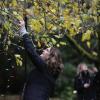April 12, 2005 - 5:00pm
Erik Lane, a fourth-year Biology student at Malaspina University-College, is trying to unlock the secrets of swimmers’ itch. That’s the red, bumpy rash that appears on human skin after contact with a parasite found in certain lakes on Vancouver Island.
Lane spent six months studying swimmers’ itch as part of his Biology 491 independent research project. He looked at the prevalence of swimmer’s itch in Westwood Lake, Long Lake and Horne Lake, and studied the life cycle of the parasite that causes it.
"All these lakes have had problems with swimmers’ itch in the past," he explained, "and with the upcoming swimming season, I thought the subject was topical. Nothing was known about the hosts of the parasite on Vancouver Island."
Dr. Tim Goater, Malaspina Biology professor and Lane’s faculty advisor, explained that all graduating biology students must complete the Biology 491 research course.
"Erik’s research stresses the value of the experience," said Goater. "He acquired valuable hands-on field and laboratory skills in ecology and parasitology, and developed a passion for curiosity-driven scientific research."
Lane’s study shows that the parasite responsible for swimmers’ itch belongs to a family of flatworms (also known as trematodes) that normally inhabit birds and mammals. In the tropics, these parasites can infect humans and cause the devastating disease known as Schistosomiasis. "Locally, there are no human schistosomes; however, schistosomes that mature in waterfowl can cause the condition known as swimmers’ itch," said Lane.
The parasite that causes swimmers' itch has a fascinating life cycle, said Lane. Eggs from the adult parasites live in waterfowl and are shed in birds’ feces, he explained. The eggs hatch in the water to a larval stage called miracidia, and amazingly they penetrate freshwater snails where they reproduce asexually to form hundreds of cercariae (a second larval stage).
"These new larvae are then shed from the snail when they mature, and swim to the water’s surface," said Lane. "Then they penetrate birds and mature into adults, and the cycle continues.
"However, at this stage, sometimes the cercariae attach to human skin because we send out the same chemical signals that birds do," explained Lane. "The larvae that penetrate human skin are killed by our immune system, but cause the irritating allergic reaction known as swimmers’ itch."
During the study, Lane and Goater collected three types of freshwater snails from the three lakes during a six month period (May to November 2004). After the first month, "it was evident that the freshwater snail, Physa gyrina, was the intermediate host for the parasite responsible for swimmers’ itch," said Lane.
"This snail species was the only one we found in all three lakes and it was the only one found to be infected with the parasite."
Westwood Lake showed no prevalence for swimmers’ itch, but seven percent of the snails found at Long Lake in June 2004 were infected.
"At Horne Lake, we found 23 percent of the snails were infected in July - which meant almost one in every four snails collected had the swimmers’ itch parasite," Lane said.
"Every time Tim and I collected snails from Horne Lake, we got swimmers’ itch on our arms when reaching into the lake. Swimmers’ itch is a real problem in Horne Lake, and my research demonstrated that one factor accounting for this is the number of infected snails. It remains a mystery as to why so many snails become infected."
Lane and Goater confirmed that the problem parasite belongs to a genus of trematodes known as Trichobilharzia. They plan to continue their research this summer to identify the exact species, and determine which waterfowl act as the definitive hosts.
Contrary to popular belief, Canada geese are not host to the parasite, said Lane. "We examined waste droppings from 92 Canada geese living near the lakes, but no samples were infected," said Lane.
However, ducks such as Mallards may be the bird host, "but we’re still trying to figure that out," he added. "We hope to work with the Nanaimo Fish and Game Club and local hunters to obtain access to ducks for dissection purposes. We’ll search for the adult parasite, which lives in the blood vessels draining the small intestine. We’ll also collect feces from Mallard and other local duck species to look for the eggs of our parasite."
Lane’s goal is to eventually submit his work to a scientific journal for publication. Following graduation in June, he hopes to land a job in the ecology field, although he has not ruled out graduate school.
"Students at Malaspina are given an experience unlike any other in the country with these Biology 491 independent research projects," said Lane. "They’re like a mini-masters project, and they teach us skills that we wouldn’t have learned in any other institution. I feel that that is one of the things that puts Malaspina University-College ahead of the rest, and I am grateful to be a student here."
Lane’s long-term goal is to become a third generation professor at Malaspina. His father Steve teaches English and Media Studies, and is the new Dean of Arts and Humanities, while his grandfather, Bob Lane, is a retired Philosophy and English professor.
Tags: In the Community






